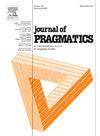自己的属格结构:着重于两个属格变体
IF 1.8
1区 文学
0 LANGUAGE & LINGUISTICS
引用次数: 0
摘要
本研究研究了两种不同的自己的格构式:s-own和of-own格构式(例如,a room of my own和my own room),表明这两种不同的格构式在语义上并不等同。本研究从构式语法的角度,比较了两种自己的属格模式的句法、语义特性和语法功能。原始频率和搭配结构分析巩固了对这两个自己的名词的句法、语义和语用特征的研究结果。结果表明,这些属格结构具有不同的语法功能。s-own属格结构允许名词短语,包括专有名词,占据所有人的位置,不受确定性的限制。相反,of-own属格结构禁止专有名词作为所有人,并要求被拥有的元素是不确定的。这些句法上的区别与语义和语用上的差异是一致的:s-own属格结构通常表示占有者前面的路径或方向,而of-own属格结构则强调占有者对生活或家庭的独特占有。此外,谓语类型还会影响属格结构的选择。动态谓语倾向于使用功能强化的s-own格,而静态谓语更倾向于使用强调所有格关系的of-own格。这些偏好反映在动词、名词和搭配的不同共现模式中。因此,本研究认为,一个人的谓语动词构成了自己独特的结构,每个谓语动词都有自己独特的句法、语义和语用特征,从而加强了它们在语义上不等同的论点。本文章由计算机程序翻译,如有差异,请以英文原文为准。
One's own genitive constructions: Focusing on two genitive variants
This study deals with two distinct patterns of own genitives: s-own and of-own genitive constructions (e.g., a room of my own and my own room), demonstrating that these distinct patterns are not semantically equivalent. From the perspective of Construction Grammar, the study compares the syntactic and semantic properties, as well as grammatical functions, of the two own genitive patterns. Raw frequency and collostructional analyses consolidate the findings on the syntactic, semantic and pragmatic characteristics of these two own genitives. The results reveal that these genitive constructions serve distinct grammatical functions. The s-own genitive construction allows noun phrases, including a proper noun, to occupy the possessor position, with no restrictions on definiteness. In contrast, the of-own genitive construction prohibits proper nouns as possessors and requires the possessed element to be indefinite. These syntactic distinctions align with semantic and pragmatic differences: the s-own genitive construction typically denotes the path or direction ahead of the possessor, whereas the of-own genitive construction highlights the possessor's unique possession of life or family. Moreover, predicate type influences the choice of genitive construction. Dynamic predicates tend to favor s-own genitives with intensifying functions, while stative predicates are more compatible with of-own genitives emphasizing possessive relationships. These preferences are reflected in distinct co-occurrence patterns with verbs, nouns, and collocations. Therefore, this study suggests that the one's own genitives form unique constructions of their own, each possessing their own distinctive syntactic, semantic and pragmatic characteristics, thereby reinforcing the argument that they are not semantically equivalent.
求助全文
通过发布文献求助,成功后即可免费获取论文全文。
去求助
来源期刊

Journal of Pragmatics
Multiple-
CiteScore
3.90
自引率
18.80%
发文量
219
期刊介绍:
Since 1977, the Journal of Pragmatics has provided a forum for bringing together a wide range of research in pragmatics, including cognitive pragmatics, corpus pragmatics, experimental pragmatics, historical pragmatics, interpersonal pragmatics, multimodal pragmatics, sociopragmatics, theoretical pragmatics and related fields. Our aim is to publish innovative pragmatic scholarship from all perspectives, which contributes to theories of how speakers produce and interpret language in different contexts drawing on attested data from a wide range of languages/cultures in different parts of the world. The Journal of Pragmatics also encourages work that uses attested language data to explore the relationship between pragmatics and neighbouring research areas such as semantics, discourse analysis, conversation analysis and ethnomethodology, interactional linguistics, sociolinguistics, linguistic anthropology, media studies, psychology, sociology, and the philosophy of language. Alongside full-length articles, discussion notes and book reviews, the journal welcomes proposals for high quality special issues in all areas of pragmatics which make a significant contribution to a topical or developing area at the cutting-edge of research.
 求助内容:
求助内容: 应助结果提醒方式:
应助结果提醒方式:


